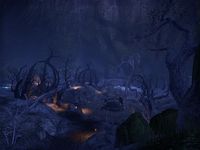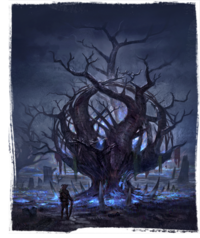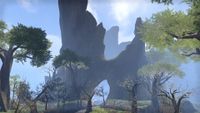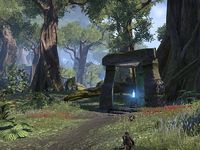Lore:Gil-Var-Delle
| Gil-Var-Delle | |
|---|---|
| Type | Bosmer Ruin |
| Continent | Tamriel |
| Province | Valenwood |
| Region | Grahtwood (Tarlain Heights) |
| Appears in | ESO |

Gil-Var-Delle (also known as Gilverdale by the Imperials)[1][2] is a ruined settlement located in western Grahtwood, in the province of Valenwood. Once a sizeable town that surrounded its Elden Tree called Lifetimber,[UOL 1] it was known as a thriving Bosmer community full of life and music,[3] but now, it is a desolate waste, one where no one dares to approach. The legend of Molag Bal's devouring of Gil-Var-Delle has cemented itself in Bosmer culture and has been the subject of several fictional pieces that dramaticize it.[4][5][6]
Contents
History[edit]

—Flaccus Terentius on his dreams of Gil-Var-Delle's devouring[7]
Gil-Var-Delle was one of the graht-oak cities of Valenwood, which all represented the mythical Tower of Green-Sap.[8] It rooted itself on the Southern Sea coast, northwest of Southpoint.[9] The town's history before its destruction is largely unknown, but it was active for most of the First Era, until its destruction.[1]
At the time, Valenwood was under the occupation of the Second Empire. To ensure the Bosmer would never rebel and unite again, they split the province into nine kingdoms, formerly minor trading posts, now with some individual autonomy. These were ruled by the former treethanes of the Camoran Dynasty who themselves lost significant power.[10][11] Gil-Var-Delle by the latemost First Era was the seat of its own kingdom as well.[UOL 2]
On the 19th of Sun's Dawn, 1E 2920, the Daedric Prince of Domination, Molag Bal appeared in a red mist over Gil-Var-Delle and destroyed the city in a single night.[1][7] The legend of how the Daedric Prince appeared in Valenwood became widespread and infamous. Though no one could technically confirm the event's true nature.[4] It is generally accepted that the perpetrator who brought Molag Bal there was the Mad King of Senchal, Dro'Zel.[1][12][UOL 2]
Dro'Zel hosted a dance party in Senchal Palace for Heart's Day and a Bosmer bard from Gil-Var-Delle arrived to tell the iconic yet tragic tale, the Legend of the Lovers. Heartbroken and frustrated by the bard for bringing the mood down, King Dro'Zel pre-maturely retired to his chambers and in a fit of rage, summoned Molag Bal to destroy the bard's hometown.[1][12] What can be said without a doubt about Gil-Var-Delle's ruining is that a great, catastrophic event occurred here and turned it into a land of death.[4] The corpse of its Elden Tree became known as Black Log[UOL 1] and the city ruins became corrupted by his remaining energies.[13] The Tribunal god, Almalexia was present around Gil-Var-Delle at the time, while she was en route to Artaeum. She was powerless to save the city, and so her tears of sorrow crystallized into a gem called Almalexia's Tear. It was said to hold all of her concentrated fury toward Molag Bal, and that no mortal can handle its power without being destroyed.[3]
After Molag Bal's devouring, Gil-Var-Delle's ruins became a blight on Valenwood's forest. He left behind large residuals of daedric energies, some of the largest in any site at the time, according to the Sapiarch of Oblivion Studies, Culalanwe. By the mid-Second Era, the ruins were still polluted with his daedric essence.[14] To the Wood Elves, it is a superstitious place that needs to be actively avoided. It is unknown if anyone survived since no one there was heard again.[4] In 2E 581, the Imperial scholar Flaccus Terentius traveled to Valenwood and somehow found his way into Gil-Var-Delle, where he went mad and disappeared, leaving behind his notes for the Improved Emperor's Guide to Tamriel. His writings were forwarded to Cyrodiil, but Flaccus Terentius by then was presumed dead.[15]
When Molag Bal's Planemeld occurred in 2E 582, the Order of the Black Worm built one of their many dark anchors in the hollowed Black Log and used devices called Fangs of Chaos to fuel it with Molag Bal's residual energy. Almalexia, sensing the disturbance in Gil-Var-Delle, sent a High Ordinator named Danys and allies from across the Fighters Guild to destroy the dark anchor. But the swarms of daedra overwhelmed them and left Danys to deal with it alone. He enlisted help from the Vestige, who Almalexia herself envisioned to arrive and destroy the dark anchor, using Almalexia's Tear to break the Fangs of Chaos. After the Worm Cult's threat was gone, Danys left to inform the Aldmeri Dominion of what just transpired.[16]
Legacy and Potential Restoration[edit]
—An excerpt from a common tavern song[3]
In response to the Devouring of Gil-Var-Delle, Sotha Sil, another one of the Tribunal, went to Molag Bal's plane of Oblivion, Coldharbour and meet with eight of the most prominent daedric princes (Azura, Boethiah, Hermaeus Mora, Hircine, Malacath, Mehrunes Dagon, Molag Bal, and Sheogorath) to arrange the Coldharbour Compact, an agreement to prevent similar events like in Gil-Var-Delle. One of the terms was for the princes to never appear in the mortal world, but only through certain intermediaries like witches or sorcerers.[17][18][19]
The catastrophic event has ingrained itself into the Wood Elves and Valenwood's subconscious. The people have long resented Molag Bal's actions and know him as the terrible demon that destroyed the city.[6][20] However, some people doubt the legend, particularly Molag Bal's involvement. The author Fastor, writer of The Devouring of Gil-Var-Delle posits a common question: "If Bal himself visited this plane with evil intent, why do any of us remain?" Some argue that someone or something stopped him, but that also lacks feasible evidence. Fastor proposes that it was a large fire that destroyed Gil-Var-Delle and that no tangible threat lingered in the ruins.[4]
It has also been the subject of many songs[3] and fictional stories that try to depict it, though none of them can be proven true.[4] One of the most famous examples includes 2920, The Last Year of the First Era written by the Third Era author, Carlovac Townway.[1][UOL 2] Another such tale states that the Silvenar sent the greatest lute-player, the Emerald Spinner Agon, to play in front of Molag Bal. His actions saved the rest of Gil-Var-Delle's citizens, but in the end, he died. He and his lute were then buried under the first graht-oak planted by King Eplear.[5]
Molag Bal's influence stayed with Gil-Var-Delle for many years, well into the mid-Second Era.[14] The fogs of Coldharbour called miasmata lingered in the ruins,[UOL 1] and the water that flowed through it became polluted and undrinkable, often referred to as blightwater.[1][UOL 1] It even poisoned some of the underground springs across Grahtwood.[UOL 1] Efforts have been made to restore the vale of Gil-Var-Delle, with people believing in the notion that all wounds heal in time. Locals travel to the site and drop blessed water into the river and bring strength to the earth.[21] Black Log holds Lifetimber Pollen which could be used to re-grow the graht-oak.[UOL 1]
By the end of the Third Era, foul energies continued to linger in the region surrounding Gil-Var-Delle. Local Bosmer were notably more resilient due to these dangers.[22]
Gallery[edit]
The local wayshrine
Notes[edit]
- Portions of Gil-Var-Delle's name can be translated from presumingly the Bosmer language based on these words in Ayleidoon. The word "Var" can translate into either "mouth" or wood",[23][24] while "Delle" can mean [to] "grant".[25][26]
See Also[edit]
- For game-specific information, see the Elder Scrolls Online article.
Books[edit]
- 2920, Sun's Dawn by Carlovac Townway — Volume 2 of a historical series about Vivec and the Empire
- From the notes of Culalanwe, Sapiarch of Oblivion Studies by Culalanwe — Research notes on residual Daedric energies after the destruction of Gil-Var-Delle
- The Devouring of Gil-Var-Delle by Fastor — On the mysterious destruction of an ancient Valenwood township
References[edit]
- ^ a b c d e f g 2920, Sun's Dawn — Carlovac Townway
- ^ Tel Mora Independent Press: Interview with Lawrence Schick
- ^ a b c d High Ordinator Danys' dialogue in ESO
- ^ a b c d e f The Devouring of Gil-Var-Delle — Fastor
- ^ a b Noryon's dialogue in ESO
- ^ a b Halls of Submission loading screen text in ESO
- ^ a b The Improved Emperor's Guide to Tamriel: Dreams of Cyrodiil — Flaccus Terentius, 2E 581
- ^ Aurbic Enigma 4: The Elden Tree — Beredalmo the Signifier
- ^ Gil-Var-Delle in ESO
- ^ Pocket Guide to the Empire, 3rd Edition: The Wilds Remain: Valenwood — Imperial Geographical Society, 3E 432
- ^ The Underroot loading screen text in ESO
- ^ a b History of Senchal: An Overview — Sulema, Initiate Scholar of the Pa'alatiin
- ^ Meva Nelenim's dialogue in ESO
- ^ a b From the notes of Culalanwe, Sapiarch of Oblivion Studies — Culalanwe
- ^ The Improved Emperor's Guide to Tamriel: Afterword — Mactator Caprenius, 2E 581
- ^ The Wakening Dark quest in ESO
- ^ The Coldharbour Compact
- ^ 2920, Rain's Hand — Carlovac Townway
- ^ Sotha Sil's dialogue in ESO: Clockwork City
- ^ Cardea Gallus' dialogue in ESO
- ^ Glothorien's dialogue in ESO
- ^ Bosmer Race Backgrounds in Oblivion Remastered
- ^ Molavar loading screen text in ESO
- ^ Eld Angavar loading screen text in ESO
- ^ Umbacano's dialogue in Oblivion
- ^ [Set Translation of Umbacano's speech 1]
Note: The following references are considered to be unofficial sources. They are included to round off this article and may not be authoritative or conclusive.
- ^ a b c d e f ESO Unused Strings
- ^ a b c Interview With Three Writers — Waughin Jarth, Baloth-Kul and Carlovac Townway


